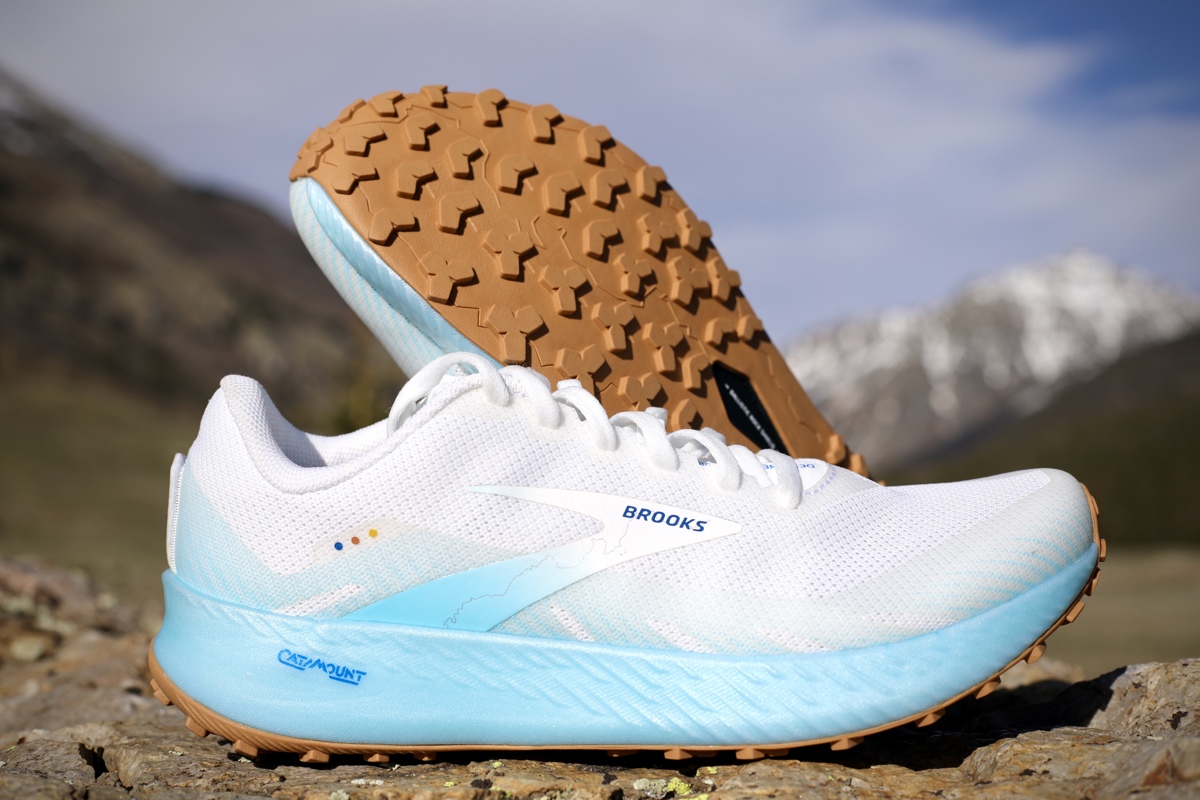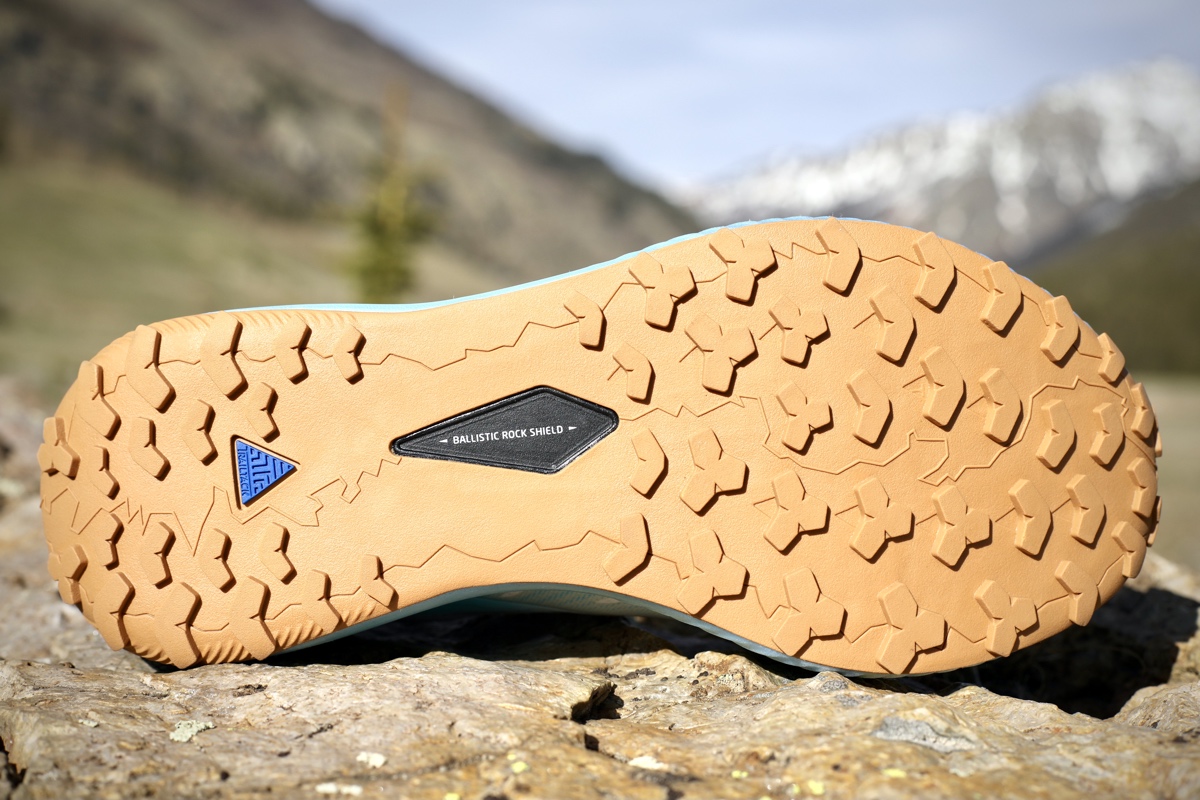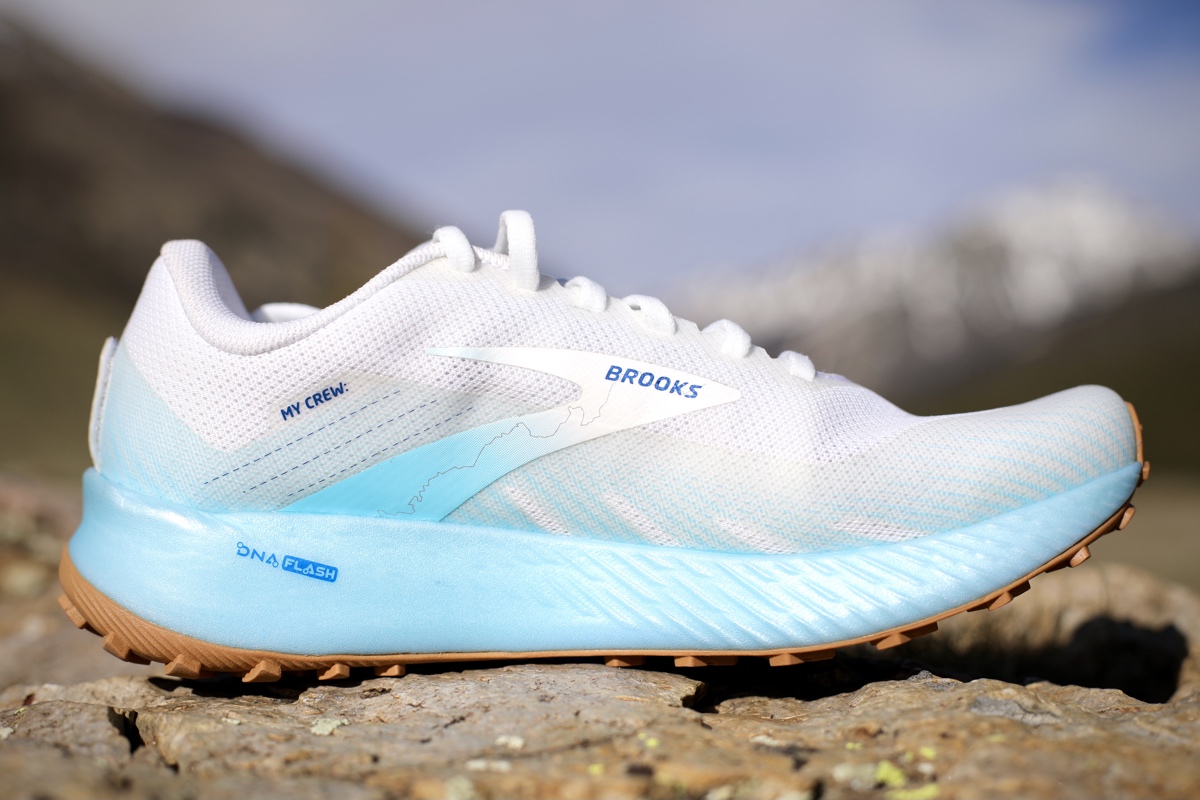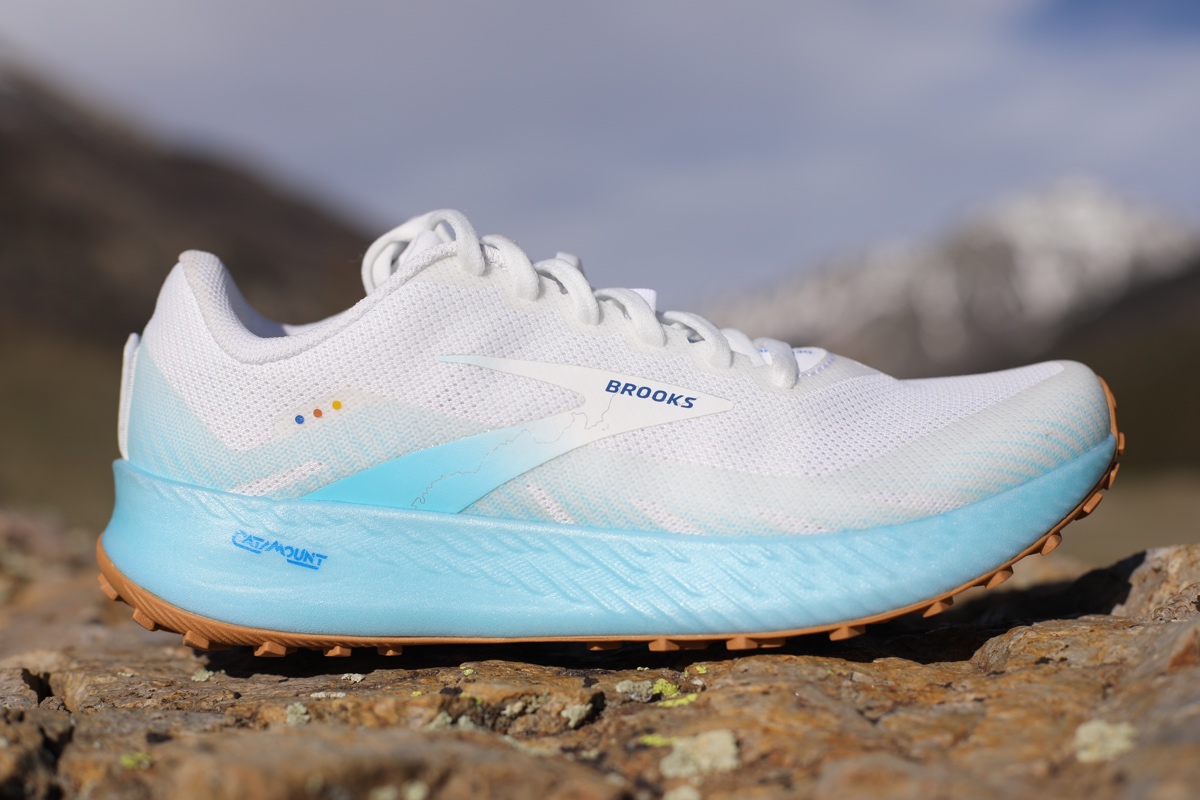For the latest on the Catamount family, read our full Brooks Catamount 3 review.
Our Favorite Trail Running Shoes
Check out our Best Trail Running Shoes buyer’s guide to learn about our current favorite trail running shoes!
Brooks Catamount Review
The Brooks Catamount ($160) was a new entrant at the running-shoe market in the second half of 2020. Brooks has positioned the Catamount as a shoe meant to go the 100-mile distance, both in all its components as well as in accents all over its upper. Standout features on the Catamount include the DNA FLASH midsole offering excellent cushioning, a flexible yet protective rock plate, and do-everything-decently outsole. At only 9.3 ounces in a men’s size 9 and with 6 millimeters of drop, the Catamount can also be a comfy daily-use shoe. Watch our video review to learn more.
We’ve named the Brooks Catamount one of the best trail running shoes!
Shop the Men's Brooks CatamountShop the Women's Brooks Catamount
Brooks Catamount Review Transcript
Hey, and welcome to Trail Trials, the video-review section of iRunFar. My name is Travis Liles, and in this video, we’re looking at the Brooks Catamount.
Let’s start off with the specs. The Catamount is a 9.3-ounce, 6-millimeter heel-to-toe drop shoe built for going 100 miles. It has accents all over it talking about running 100 miles in a day. It’s got a trail map on it. It even has a spot: put your crew on there. Let’s get up close and personal, and see what it’s all about.
Brooks Catamount Outsole
Let’s start by talking about the outsole on the Brooks Catamount. On the outsole, Brooks uses what’s called their TrailTack, and this compound is really for being sticky, working in a lot of different conditions. Whether I was on dry ground, wet ground, gravel, slick rocks, or wet wood bridges, this did a really nice job across all of those environments. They do that, one, with the TrailTack and, two, with having these good-enough lugs. They’re not super deep, but they work. They are both directions. You have the reverse-direction lugs for braking when you’re going downhill, and then you have the forward-facing lugs in the front when you’re climbing.
On the bottom, the [Ballistic] Rock Shield is sandwiched in between the midsole and outsole. It’s not a full-length rock plate. It’s a rock plate that starts right here at this back corner of the logo, and then works its way up underneath the ball of your foot and around your toes. It is not an overly hard rock shield. You can see the shoe is still pretty flexy and that makes for a good feel while adding protection. I never noticed anything poking through or having fatigue. So the [Ballistic] Rock Shield is, again, enough to provide protection, but it’s not so much that it is a negative or gives the shoe a stiff feeling.
You can probably see this line running along the shoe. That is one example of the Western States Trail being called out, the track of that.
Brooks Catamount Midsole
Let’s move up to the midsole. The standout feature on the Brooks Catamount is the DNA FLASH, their DNA midsole, and then they inject it with nitrogen. The majority of the industry is experimenting with new ways of making midsoles. You see that with Nike’s ZoomX foam, you see that with Altra’s EGO, Saucony has their EVERUN, and Adidas has their Boost. All of these are higher-end ways of making EVA foam and trying to do something different with them, making them more spongy, springy, durable, and lightweight. Whatever that thing is that they’re looking for, that’s what’s going on.
So this foam is really fairly lightweight. For the amount of protection and what this shoe is, the fact that it’s under 10 ounces is fairly impressive, and a lot of that has to do with the lightness of the midsole. This midsole is a really strong performer. You can see when you look straight down, this has that rocker feel. It’s not a highly aggressive rocker, but there’s enough there that you’ll get that rolling feeling when you’re wearing it. That combined with this DNA FLASH, which is a snappy foam so you kind of feel that push forward and rebound versus just being more of a neutral foam, performs well.
It is a single density all the way around—you can see this black here. There are not any breaks or blocks or some other type of foam added. It’s all the same all the way through. When you look at this, it’s a little bit more of a flatter-looking midsole, which is standard Brooks or even the Cascadia had that look. You fit down inside of this a little bit. Your heel is going to sit maybe around where the text “Catamount” is on the bottom, so it adds a little bit of a secure fit. You fit down inside of the shoe versus riding on top of it.
Brooks Catamount Upper
Let’s transition to the upper on the Brooks Catamount. The upper is fairly simple. It is all mesh with the exception of this rubber overlay that is all the way around the shoe, which adds protection, a little bit of water resistance on the shoe, and structure to the upper itself. I like to have a little bit more structure there because it keeps my foot in place, and especially if I’m going long distances, I want to keep that movement to a minimum so the friction stays down, and there’s just enough that lets that happen without overbuilding the shoes, without making it too heavy.
On the front, we have that overlay that adds some structure to the toebox, but it’s still fairly flexible. All the way at the apex of the toebox, we’re bringing the outsole around and have a fairly strong toebox, and it gets just a little bit looser the farther away we get from the very tip of the shoe. You can see that overlay is all the way around and there are some cutouts at the toe and toward the back where that mesh is exposed and lets water out of the shoe. So water crossings and those sorts of things, the shoe will drain fairly well.
A couple of other things, aesthetically. Here’s another example of the Western States Trail and medially there is another example of the Western States Trail, so they’re really going for something here. Then even on the back, you can see the words, “My Crew,” where you write your crew’s name.
Then one more spot on the tongue says, “100 Miles Run Happy.” Make no mistake in what Brooks is going after on this shoe. It is not hidden and, in fact, the last time I remember this amount of attention was probably on the Cascadia 4. This isn’t the first time Brooks has done something like this. I do think it’s interesting that it is happening on another shoe other than the Cascadia.
The last couple of things I want to call out from a structure standpoint, from a shoe-wrap standpoint of keeping the shoe locked into your foot. Underneath all of these laces, you can’t see it because it’s sandwiched in between the outer layer of mesh and the inner sock liner, are some sort of straps that connect the lace to the underneath of the shoe or to the midsole that allows this shoe to lock in. You can’t see it visually, but if you rub your hands through here, you can feel where they are. So each one of the eyelets has an individual strap inside of the shoe. It’s flat. You don’t notice it by wearing it, just really if you run your hand through it, that gets the shoe locked in fairly well. If you have a really narrow heel, this could be a problem because there is not a lace beyond this top one, but you might be able to punch another one through because there’s still a little bit of rubber overlay.
The heel cup is fairly flexible. It collapses so there’s not a hard piece of plastic anywhere. It’s got a little bit of structure to it, but again, this overlay is the structure. You can see that it folds at that point, but there’s nothing inside that is hard and has a rigid feel.
The last thing I’ll call out is that the tongue is in this middle ground. I would’ve liked to see a little bit more padding on it, but they did an okay job of sitting in the middle of what the industry tends to be doing. This is a middle-thickness tongue, but then they did the weight savings by—you can see those little holes. One, you’re going to get a little bit of ventilation out of that, but it’s also weight savings. Lastly, you have a gaiter spot in the back to attach your gaiters to.
Brooks Catamount Overall Impressions
Overall, what you have in this Brooks Catamount package is something that does well across a lot of different environments. They kept the necessary things, they cut away some of the stuff that they didn’t need, and you’re able to have a shoe that can do a lot at under 10 ounces, provide some protection, provide some comfort and, hopefully, keep you going for a long time.
In closing, I think Brooks has a hit on their hands. I have not worn Brooks in a long time, mainly because the Cascadia just hasn’t changed, and that’s a really positive thing. We don’t see a lot of that in the running-shoe industry anymore, where we get a model that gradually changes over time. In fact, if you’d have asked me five years ago what I thought the Cascadia would’ve been, it would’ve been this shoe.
This shoe meets all the current check boxes of what we’re seeing in trail running shoes. It’s got a little bit of that rocker feel to it. It’s got an advanced foam that’s very springy, yet protective, it’s cushiony. Nike’s got their foam. Adidas has their foam. Altra has their foam. Everybody’s got a special, new foam compound, and that’s what’s going on. It’s a secure fit. It’s got enough protection underfoot that it keeps things from poking through, but doesn’t feel so rigid that you can’t move fast and get the feel of the trail. The lugs are all-purpose. They work across a whole bunch of terrain. It’s a shoe that I gravitate toward because it does a lot of things well.
I don’t know that it does anything really well specifically. It’s not the best downhill shoe I have. It’s not the best uphill shoe I have. It’s not the grippiest shoe I have. But it ticks enough boxes that when you’re covering a long distance, like 100 miles—which this shoe is specifically pointed toward with these trail maps and putting your crew name on here—it’s what you’re looking for. With all of those components present on this shoe, in an updated package, in a shoe that breathes well, that’s attached to your foot, it just does a lot of things that you’re going to like when you’re going a long distance and you’re getting into stuff that is changing. You hit rugged terrain, you hit uphills, you hit downhills, you hit road sections. You don’t have to think about changing into something else. That’s what they’re going for, and they did a pretty good job. Still reading? Buy now from REI.com or Backcountry.com and your purchases help support iRunFar.
Shop the Men's Brooks CatamountShop the Women's Brooks Catamount
Call for Comments
Questions, comments, feedback of your own, place those below this video. Thanks for watching, and we’ll catch you next time.
[Editor’s Note: If you’re affiliated (i.e., an employee, ambassador, etc.) with a brand, please share your relation in each of your comments on this article. Thanks!]





